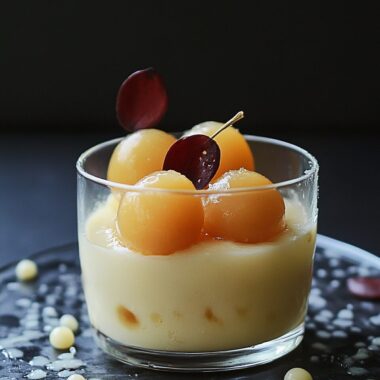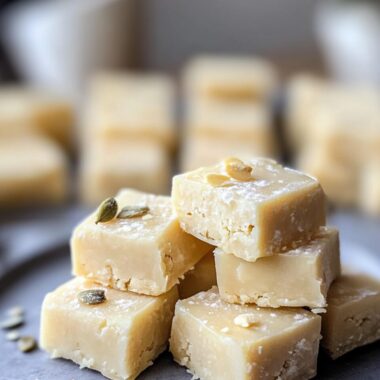The humble samosa gets a vegan makeover in this crispy and flavorful rendition of a beloved classic. Stuffed with spiced mashed potatoes and tender green peas, these pockets are wrapped in a homemade dough and fried until golden perfection. Whether you’re preparing them as a savory appetizer, a party treat, or just a cozy snack at home, these vegan samosas bring a comforting and satisfying experience. They pair beautifully with chutneys or sauces and can even be air-fried for a lighter option. Deliciously simple, yet wonderfully impressive.
Full Recipe:
Ingredients:
For the Dough:
-
2 cups all-purpose flour
-
1/4 cup oil (such as sunflower or vegetable)
-
1/2 teaspoon salt
-
6 tablespoons cold water (more if needed)
For the Filling:
-
3 large potatoes, peeled and diced
-
1/2 cup green peas (fresh or frozen)
-
1 tablespoon oil
-
1 small onion, finely chopped
-
2 cloves garlic, minced
-
1 teaspoon grated ginger
-
1 green chili, finely chopped (optional)
-
1/2 teaspoon ground cumin
-
1/2 teaspoon ground coriander
-
1/2 teaspoon garam masala
-
1/4 teaspoon turmeric
-
Salt and pepper to taste
-
Fresh cilantro, chopped (optional)
For Frying:
-
Neutral oil for deep frying
Directions:
-
Boil the diced potatoes in salted water until tender. Drain and mash slightly, leaving some chunks. Add peas and set aside.
-
In a skillet, heat oil over medium heat. Sauté onion until translucent. Add garlic, ginger, and chili. Cook for another minute.
-
Stir in cumin, coriander, garam masala, turmeric, salt, and pepper. Add potato-pea mixture and combine well. Add chopped cilantro if using. Let cool.
-
For the dough, combine flour and salt in a bowl. Add oil and rub into the flour until crumbly. Gradually add water, kneading into a firm dough. Cover and rest for 30 minutes.
-
Divide dough into 6-8 balls. Roll each into an oval, cut in half. Form a cone with each half, sealing the edge with water.
-
Fill each cone with the potato mixture, then seal the top. Repeat with remaining dough.
-
Heat oil in a deep pan to 350°F (175°C). Fry samosas in batches until golden and crispy. Drain on paper towels.
Prep Time: 40 minutes | Cooking Time: 20 minutes | Total Time: 1 hour
Kcal: 220 kcal | Servings: 8 samosas
The Rich History of the Samosa
The samosa is a culinary icon with roots tracing back over a thousand years. Though widely associated with Indian cuisine today, its origins can be found in the Middle East and Central Asia, where it was known as sambosa. Travelers and traders carried it along trade routes to the Indian subcontinent, where it was embraced and reinterpreted using local ingredients and spices.
Over time, the samosa evolved into what many now consider a staple street food and household snack in India, Pakistan, Nepal, and Bangladesh. Traditionally stuffed with spiced potatoes, peas, and sometimes meat, samosas are deep-fried to golden, crispy perfection. This vegan version honors the classic taste and texture while keeping it plant-based and accessible for modern diets.
Why Choose a Vegan Version?
Samosas are naturally easy to veganize. The dough is traditionally made without dairy, and the filling usually a mixture of potatoes and peas requires only minor tweaks to become fully plant-based. By using vegetable oil and omitting any ghee or butter, we preserve the flavor while making the dish suitable for vegan and dairy-free lifestyles.
Choosing vegan samosas not only supports ethical eating practices but also opens the dish up to people with dietary restrictions. It’s also more environmentally friendly, aligning with sustainable food goals. And let’s not forget they’re absolutely delicious and satisfying without any compromise in taste.
A Global Favorite with Many Faces
Though the potato-and-pea combination is the most well-known, samosas can be found in countless variations across the world. In India alone, regional spins might include the addition of lentils, nuts, or dried fruits like raisins. In the Middle East, versions may be filled with minced meat or cheese. In East Africa, particularly Kenya and Tanzania, samosas often called sambusas frequently include spiced beef or lentils.
The versatility of samosas makes them a wonderful canvas for culinary creativity. For a fusion approach, you might try Mexican-inspired samosas with black beans and corn, or a Mediterranean version with olives and sun-dried tomatoes. The possibilities are endless.
Healthier Cooking Methods
Traditionally, samosas are deep-fried for that irresistible golden crust and crispiness. However, if you’re looking to enjoy them more frequently or in a lighter form, there are several healthier cooking alternatives that don’t sacrifice flavor.
-
Air Frying: One of the best modern solutions. Air-fried samosas come out crispy and golden with a fraction of the oil.
-
Baking: Baking your samosas in a high-heat oven results in a crunchy exterior with less mess and less oil.
-
Pan-Frying: For a balance between crispy texture and less oil use, pan-frying in a shallow amount of oil is a great middle ground.
These techniques allow you to enjoy your favorite snack while keeping things heart-healthy and weight-friendly.
Tips for Perfect Vegan Samosas
Get the Dough Just Right
The dough should be firm and smooth but not too soft. Letting it rest for at least 30 minutes helps develop gluten, making the samosas easier to roll and shape. Be careful not to overfill or leave air pockets, which can cause them to burst during frying.
Spice it Up Mindfully
The filling is where the magic happens. Toasting your spices before mixing them with the potatoes intensifies their aroma and flavor. Adjust the heat level to your preference by using green chili, chili flakes, or even a dash of cayenne.
Seal the Edges
To prevent the samosas from opening during cooking, seal them well with a paste of flour and water. Press firmly along the seams and consider crimping the edges slightly with a fork for an extra secure and stylish finish.
Make-Ahead Friendly
Samosas are freezer-friendly! Prepare and shape them ahead of time, then freeze on a tray before transferring to a bag or container. Fry or bake directly from frozen, adjusting the cooking time slightly.
Serving Ideas and Accompaniments
Samosas are incredibly versatile and can be served as an appetizer, snack, or even a main course when paired with sides. They’re traditionally enjoyed with chutneys mint, tamarind, or coriander-based varieties are all classic companions. For a heartier meal, serve them with a simple lentil dal or chickpea curry.
Hosting a party? Create a DIY samosa platter with dips and sauces, offering a variety of fillings and spice levels to suit different palates. Want to keep it light? Pair your samosas with a refreshing cucumber salad or a tangy yogurt dip made from plant-based yogurt.
Cultural and Social Significance
In many cultures, samosas hold more than just culinary value. They’re a symbol of hospitality, often served during festivals, weddings, and special gatherings. In India, they’re a common fixture at roadside tea stalls served hot with a cup of masala chai during the rainy season.
Their portability and ease of sharing have made them a favorite around the world, turning a simple triangular snack into a global street food phenomenon. Whether you enjoy them on a festive table or as a midnight snack, they always deliver comfort and joy.
Conclusion:
Vegan samosas are the perfect example of how classic comfort food can be adapted to suit modern diets without losing any of their soul. With their flaky crust and warmly spiced interior, they are both nostalgic and exciting, traditional and adaptable. Whether you’re making them for a celebration or just a cozy night in, these crispy delights promise satisfaction in every bite.
Their adaptability, cultural significance, and pure flavor make them a must-try for anyone exploring plant-based cooking. Once you make a batch, you’ll quickly understand why they’ve earned such a beloved place in kitchens around the world. Try pairing them with your favorite chutney or invent your own twist—they’re more than just a recipe, they’re a celebration on a plate.








